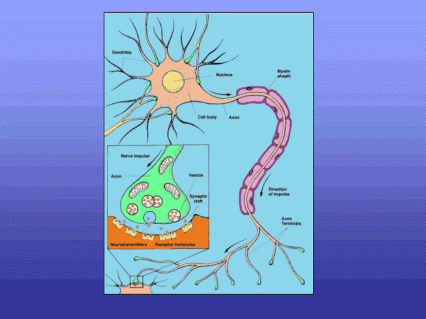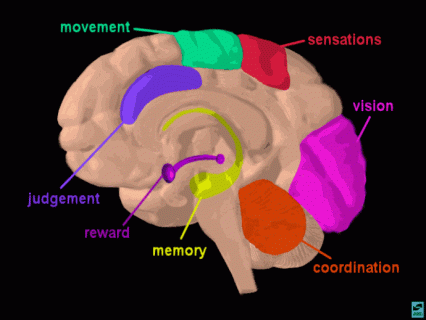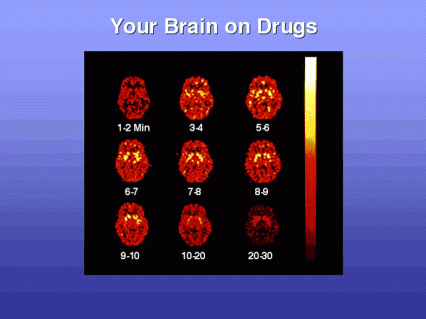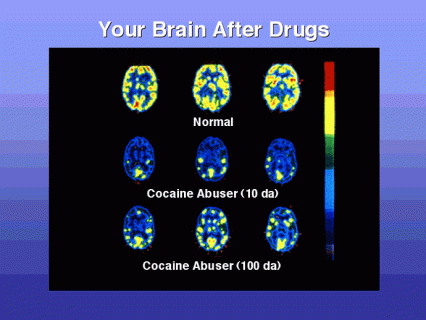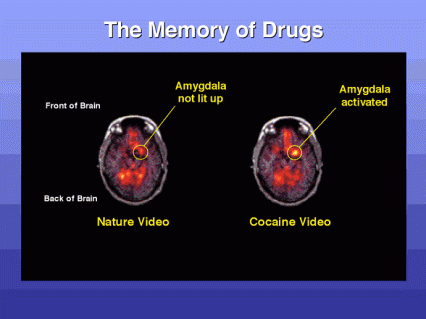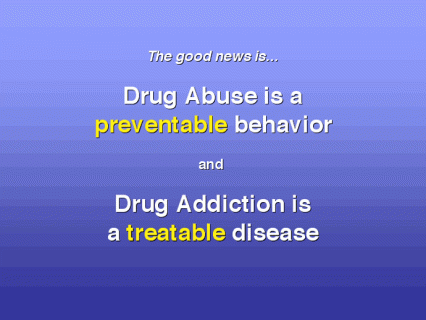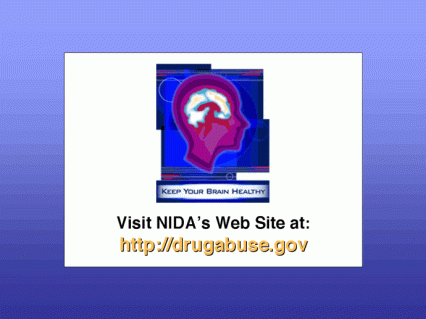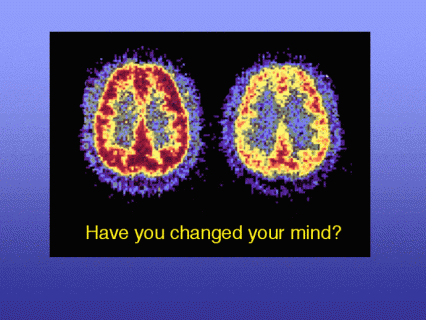The fifth in a 5-part series, summarizes the science behind drug abuse and addiction, reviews the harmful consequences of drug use, and poses the question of whether it is worth the risk. This presentation can be downloaded as a Powerpoint file - Bringing the Power of Science to Bear on Drug Abuse and Addiction (PPT, 1.3MB) and was last reviewed in January, 2007.
- NIDA is dedicated to bringing the power of science to bear on drug abuse and addiction
-
The National Institute on Drug Abuse (NIDA) is part of the National Institutes of Health and is dedicated to bringing the power of science to bear on drug abuse and addiction.
When a person first thinks about trying drugs, it is usually a voluntary decision. “Maybe I should see what it’s like... just this once,” you might think. Or a friend dares you. Or you just want to feel good or forget your troubles. Most drugs of abuse - including nicotine, alcohol, marijuana, cocaine, and heroin - activate a part of the brain called the reward system, and that makes you feel good. But just for a little while.
Drug abuse has serious consequences. The most serious consequence is that prolonged drug use can change the brain in fundamental and long-lasting ways. Eventually, it becomes difficult to deerive pleasure from other normal activities, such as sports, food, or sex.
After repeated drug use, you reach a point when deciding to use drugs is no longer voluntary. Scientists have proof now that drugs literally change your brain. It’s as if a “switch” goes off in the brain. It is during this transformation process that a drug abuser becomes a drug addict.
Addiction is a chronic relapsing disease characterized by compulsive, often uncontrollable, drug seeking and drug use in the face of negative consequences. Drug addicts need professional help and treatment to help them cope with these changes and possibly change the brain back to normal.
- The brain is the most complex organ in the body
-
The brain is made up of a complex network of billions of nerve cells called neurons, as well as other kinds of cells, all protected by the bones of the skull. The typical brain weighs only about 3 pounds, but it is the source of most qualities that make you who you are. Neurons in the brain and spinal cord are part of the nervous system and act as a body’s “Command Central.”
The brain is constantly active, even when we are asleep. As a matter of fact, asleep or awake, the brain requires 20 percent of the heart’s output of fresh blood and 20 percent of the blood’s oxygen and glucose to keep functioning properly. Glucose is a type of sugar that is our brain’s primary fuel.
The brain produces enough electrical energy to power a 40-watt light bulb for 24 hours. That’s a lot of energy for a human organ a little bigger than a softball.
- How a neuron works
-
Neurons are unique because they can send information from the brain to the rest of the body. Your brain communicates with the rest of your body by sending messages from one neuron to the next and ultimately to the muscles and organs of the body. Neurons can also store information as memories.
Typically, a neuron contains three important parts: a cell body that directs all activities of the neuron; dendrites (the part that looks like tree branches), which are short fibers that receive messages from other neurons and relay those messages to the cell body; and the axon, a long single fiber that transmits messages from the cell body to dendrites of other neurons. Every moment, messages are moving with amazing speed back and forth from neuron to neuron. As a matter of fact, scientists often compare the activity of neurons to the way electricity works.
A neuron communicates with other neurons at special places called synapses or synaptic clefts. To send a message, a neuron releases a chemical messenger, or neurotransmitter, into the synaptic cleft. From there, the neurotransmitter crosses the synapse and attaches to key sites called receptors on the next neuron in line. When neurotransmitters attach to these receptors, they cause changes inside the receiving neuron and the message is delivered.
Neurons communicate with each other through a network of interconnected cells that scientists are still trying to fully understand. Scientists do know that this complex communication system within the brain can be disrupted by the chemicals in drugs. Did you know that more than 400 chemicals are in a marijuana leaf? And over 4,000 chemicals besides nicotine are in tobacco!
- The brain is your body
-
Your brain controls more than the way you think. The brain controls our physical sensations and body movements. How we understand what we see, hear, smell, taste, and touch. Our sense of balance and coordination. Memory. Feelings of pleasure and reward. The ability to make judgments. When we catch a football, dance, jog, speak, sing, laugh, whistle, smile, cry - that’s our brain receiving, processing, and sending out messages to different parts of our body.
When we feel good for whatever reason - laughing with a friend or seeing a good movie or eating our favorite ice cream - the brain’s reward system is activated. As we said before, the reward system is the part of the brain that makes you feel good. The reward system is a collection of neurons that release dopamine, a neurotransmitter. When dopamine is released by these neurons, a person feels pleasure.
Scientists have linked dopamine to most drugs of abuse - including cocaine, marijuana, heroin, alcohol, and nicotine. These drugs all activate the reward system and cause neurons to release large amounts of dopamine. Over time, drugs damage this part of the brain. As a result of this damage, things that used to make you feel good - like eating ice cream, skateboarding, or getting a hug - no longer feel as good.
- Control centers in the brain are affected by drug use
-
Drugs of abuse disable or disrupt important brain functions. When someone smokes marijuana, for example, the chemical THC (delta-9-tetrahydrocannabinol), the main psychoactive ingredient in marijuana, travels quickly to the brain. We can see the areas of the brain (in dark pink) where THC concentrates. Let’s go back to the previous image and see the areas of the brain that are affected by THC. You can see that THC builds up in areas that control the body’s movements, balance, coordination, memory and judgment abilities, and sensations. THC disrupts your brain’s ability to control these activities as well as you could normally.
- A positron emission tomography (PET) scanner
-
Now let’s take a look inside your mind... One of the tools that scientists use to see the effects of drugs on the brain is called positron emission tomography or a PET [say the word “pet”] scan. Similar to an x-ray, but much more sophisticated, a PET scan is used to examine many different organs including the heart, liver, lungs, and bones, as well as the brain. A PET scan shows much more than the physical structure of bone and tissue. A PET scan shows how well (or how little) an organ is functioning.
Using a PET scan, a doctor or a scientist can see what is actually happening in a person’s brain and see the effects of drugs. The PET scan shows areas of the brain that are active and also areas that are inactive or not functioning at all. Typically, a PET scan takes 1 to 2 hours with the person lying completely still so that the PET images will be clear.
Let’s see the effects a drug like cocaine has on the brain.
- This is literally the brain on drugs
-
When someone gets "high" on cocaine, where does the cocaine go in the brain? With the help of a radioactive tracer, this PET scan shows us a person's brain on cocaine and the area of the brain, highlighted in yellow, where cocaine is "binding" or attaching itself. This PET scan shows us minute by minute, in a time-lapsed sequence, just how quickly cocaine begins affecting a particular area of the brain
We start in the upper left hand corner. You can see that 1 minute after cocaine is administered to this subject nothing much happens. All areas of the brain are functioning normally. But after 3 to 4 minutes [the next scan to the right], we see some areas starting to turn yellow. These areas are part of a brain structure called the striatum [stry-a-tum] that is the main target in the brain bound and activated by cocaine.
At the 5- to 8-minute interval, we see that cocaine is affecting a large area of the brain. After that, the drug's effects begin to wear off. At the 9- to 10-minute point, the high feeling is almost gone. Unless the abuser takes more cocaine, the experience is over in about 20 to 30 minutes.
Scientists are doing research to find out if the striatum produces the "high feeling" and controls our feelings of pleasure and motivation. One of the reasons scientists are curious about specific areas of the brain affected by drugs such as cocaine is to develop treatments for people who become addicted to these drugs. Scientists hope to find the most effective way to change an addicted brain back to normal functioning.
- Long-term effects of drug abuse
-
This PET scan shows us that once addicted to a drug like cocaine, the brain is affected for a long, long time. In other words, once addicted, the brain is literally changed. Let’s see how...
In this image, the level of brain function is indicated in yellow. The top row shows a normal-functioning brain without drugs. You can see a lot of brain activity. In other words, there is a lot of yellow color.
The middle row shows a cocaine addict’s brain after 10 days without any cocaine use at all. What is happening here? [Pause for response.] Less yellow means less normal activity occurring in the brain - even after the cocaine abuser has abstained from the drug for 10 days.
The third row shows the same addict’s brain after 100 days without any cocaine. We can see a little more yellow, so there is some improvement - more brain activity - at this point. But the addict’s brain is still not back to a normal level of functioning... more than 3 months later. Scientists are concerned that there may be areas in the brain that never fully recover from drug abuse and addiction.
- Drugs have long-term consequences
-
Here is another example of what science has shown us about the long-term effects of drugs. What this PET scan shows us is how just 10 days of drug use can produce very dramatic and long-term changes in the brain of a monkey. The drug in these images is amphetamine, or what some people call “speed.” Remember the previous image showed us what the brain of a chronic cocaine abuser looks like. This image shows us what using a drug like amphetamine can do in only 10 days to the brain of a monkey.
This image also gives us a better idea of what methamphetamine, a drug similar in structure, can do to the brain. Methamphetamine use is becoming increasingly popular in certain areas of the country.
The top row shows us, in white and red, normal brain activity. The second row shows us that same brain 4 weeks after being given amphetamine for 10 days. There is a dramatic decrease in brain activity. This decreased brain activity continues for up to 1 year after amphetamine use. These continuous brain changes often trigger other changes in social and emotional behavior, too, including a possible increase in aggressiveness, feelings of isolation, and depression.
- The memory of drugs
-
This image demonstrates something really amazing - how just the mention of items associated with drug use may cause an addict to “crave” or desire drugs. This PET scan is part of a scientific study that compared recovering addicts, who had stopped using cocaine, with people who had no history of cocaine use. The study hoped to determine what parts of the brain are activated when drugs are craved.
For this study, brain scans were performed while subjects watched two videos. The first video, a nondrug presentation, showed nature images - mountains, rivers, animals, flowers, trees. The second video showed cocaine and drug paraphernalia, such as pipes, needles, matches, and other items familiar to addicts.
This is how the memory of drugs works: The yellow area on the upper part of the second image is the amygdala (a-mig-duh-luh), a part of the brain’s limbic system, which is critical for memory and responsible for evoking emotions. For an addict, when a drug craving occurs, the amygdala becomes active and a craving for cocaine is triggered.
So if it’s the middle of the night, raining, snowing, it doesn’t matter. This craving demands the drug immediately. Rational thoughts are dismissed by the uncontrollable desire for drugs. At this point, a basic change has occurred in the brain. The person is no longer in control. This changed brain makes it almost impossible for drug addicts to stay drug-free without professional help. Because addiction is a brain disease.
- A message to remember
-
We discussed many important points today. Two points, in particular, I hope you remember. One is that drug abuse and addiction affect every segment of society. That’s all of us. Everyone. Not one person is immune from the disease of addiction.
These images today demonstrate that there are observable changes in brain function that take place when drugs are used. We saw that the brains of addicts are different from the brains of people who are not addicted. And it is difficult, in some cases impossible, to return the brain to normal. Scientists, like those who work at the National Institute on Drug Abuse, are working to develop treatments to help people who are addicted to drugs. But treatment, like addiction, is a complex issue.
- Is it worth the risk?
-
What percentage of people who experiment with drugs will become addicted? [Pause for responses.] Right now, science doesn’t have the answer to that question. The effects of drugs on the brain are still being studied and explored.
And when we talk about drugs, we are not just talking about cocaine and marijuana and amphetamines and inhalants. Nicotine is highly addictive too, and, for many people, so is alcohol. Forget the stereotype of a drug addict hanging out on a dangerous street corner. Anyone can get hooked on drugs - your friends, members of your family, your neighbors.
Trying a drug just because a friend says it’s “cool,” might cost you much more than you bargained for. So every person in this room has to decide for themselves: Is it worth the risk?
The good news is: Help is available.
- Visit NIDA
-
We’ve covered a lot of ground today. By now everyone here should have an idea of what drugs do to our brain, but the information we shared today is just a beginning. There’s much more to discover about how the brain works. Take some time on your own to learn about this subject. The Internet is an excellent place to start.
To learn more, check out NIDA’s home page on the World Wide Web and see what you can find out about the latest discoveries about the brain and how it responds to drugs.
For scientists, the brain is unexplored territory like the surface of Mars for the Pathfinder expedition. It is my hope that some of you will become scientists interested in how the brain works, so that you might help us understand more about addiction and help us solve this problem.
- Have you changed your mind?
-
Here is our last image. As we look at side-by-side PET scans of a person who has never used cocaine compared with a cocaine addict, can you tell which brain is more active and healthy? Take a guess. Yes, the brain on the left with an abundance of red is the healthy, active brain.
With a little bit of knowledge about what drug addiction actually is, anyone - not just neuroscientists and neurobiologists - can see the changes in brain activity caused by drug abuse and addiction. The PET scans we’ve looked at today prove that.
We’ve seen the scientific facts. We’ve learned that addiction is a brain disease. And we’ve also learned that scientists are making great strides in developing treatments for addiction. There will be no magic charm to make addiction go away. But educated and informed with the scientific facts about what drugs can do to the brain, we are each in a better position to decide whether or not to take drugs in the first place. Given the facts, have you changed your mind?



